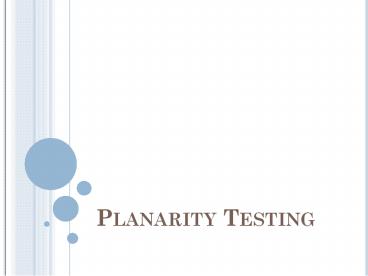Planarity Testing - PowerPoint PPT Presentation
Title: Planarity Testing
1
Planarity Testing
2
Overview
- Definitions
- Mengers Theorem
- Ear Decomposition Lemma
- Pieces
- Planarity Testing Algorithm
- Complexity O(n )
3
Well only discuss connected undirected graphs
3
Definitions
- Cut vertex
- Cut edge
- Block
- Two blocks share at most one vertex cut-vertex
Connected Components
1
3
Connected Components
1
2
4
DFS
- Depth First Search
- Use the DFS tree to find Blocks
G
DFS tree
5
Mengers Theorem (1927)
- k-connected deleting (k-1) vertices cannot
disconnect it (V(G) gt k). - Corollary (Dirac 1960)
- G is 2-connected ? G consists of a single block
6
ST-Ordering
- Numbering - v1, v2, ... , vn of V(G) so that
- (v1, vn) E(G)
- vi has a neighbor vj where j lt i
- vi also has a neighbor vk where i lt k
(for every i , 1 lt i lt n) - G admits an st-ordering ? G is 2-connected
Well prove it soon
7
Ear Decomposition Lemma
- Every 2-connected graph can be obtained from a
cycle by adding paths - For each path
- Both end points are on the current graph
- But otherwise it is disjoint from it
- Proof
- Gi G, Gi ? G the current graph.
- Pick u V(Gi) , v V(Gi) such that (u, v)
E(G) and connect v to Gi by a shortest path.
8
G admits an st-ordering ? G is 2-connected
- G is 2-connected
- Use induction on E(G)
- Show G admits st-ordering with
- v1 u, v2, ... , vn v (u, v) E(G)
- Pick a cycle C through (u, v)
- Base
- G C
- trivial
u
v
(v5)
(v1)
v2
v4
v3
9
Continued
- C ? G
u
v
(v5)
(v1)
G
G0 C
10
Continued
- C ? G
- Add a path to it as in the ear decomposition
- Number the paths vertices so they form an
increasing chain connecting its endpoints
u
v
(v5)
(v1)
G0 C
G1
v4
v3
Shortest path
11
Continued
- C ? G
- Add a path to it as in the ear decomposition
- Number the paths vertices so they form an
increasing chain connecting its endpoints
u
v
(v5)
(v1)
G1
G2
v2
v4
v3
12
Pieces
- G is 2-connected
- C is a cycle in G
- Pieces
- C is Separating
P2
P1
P3
13
Pieces
- Pieces can be drawn on either side of C
P2
P1
P3
14
Pieces
- Pieces can be drawn on either side of C
P2
P1
P3
15
Pieces
- Pieces can be drawn on either side of C
P2
P1
P3
16
Pieces
- Pieces can be drawn on either side of C
P2
P1
P3
17
Pieces
- Two pieces Interlace or Conflict if they cannot
be drawn on the same side of C without crossing
edges - When does this happen?
P2
G
G
a1
Cyclic order a1, b1, a3, b3
P1
a2
b1
b3
P3
a3
b2
18
Pieces
- G might be a planar graph
P2
G
P1
P3
19
Pieces
- G might be a planar graph
- If one of the conflicting pieces can be drawn on
the other side of C
P2
G
P1
P3
20
Our Goal
- Find 2 sets (S1, S2) of pieces so that
- No two pieces in the same set conflict
- S1 S2 C G
n
n
P2
G
S1 P1, P2 S2 P3
P1
P3
21
Interlacement Graph
- Vertex set the set of pieces (with respect to
C) - Two vertices are connected ? the pieces interlace
Interlacement(G, C)
P2
G
P1
P3
22
Is G planar?
- G 2-connected graph with cycle C
- G is planar ?
- For each piece P (with respect to C)
- P C is a planar graph
- The Interlacement graph is bipartite
(2-colorable)
n
23
Why?
P2
Interlacement(G, C)
G
S1
P1
S2
If Interlacement(G, C) is bipartite, we can
divide the pieces to 2 sets - like we wanted
P3
24
Why?
- Each piece combined with C is a planar graph
- And we can assemble all the pieces together so
that they dont interlace - So G is planar
25
Planarity Testing Recursive Algorithm
- G 2-connected graph with
- n vertices
- O(n) edges
- C is a cycle in G
- The Algorithm
- Find pieces with respect to C
- Build interlace graph
- Check if it is bipartite
- Check planarity for Cs pieces (recursively)
(
)
O(n)
O(n)
26
Questions?































